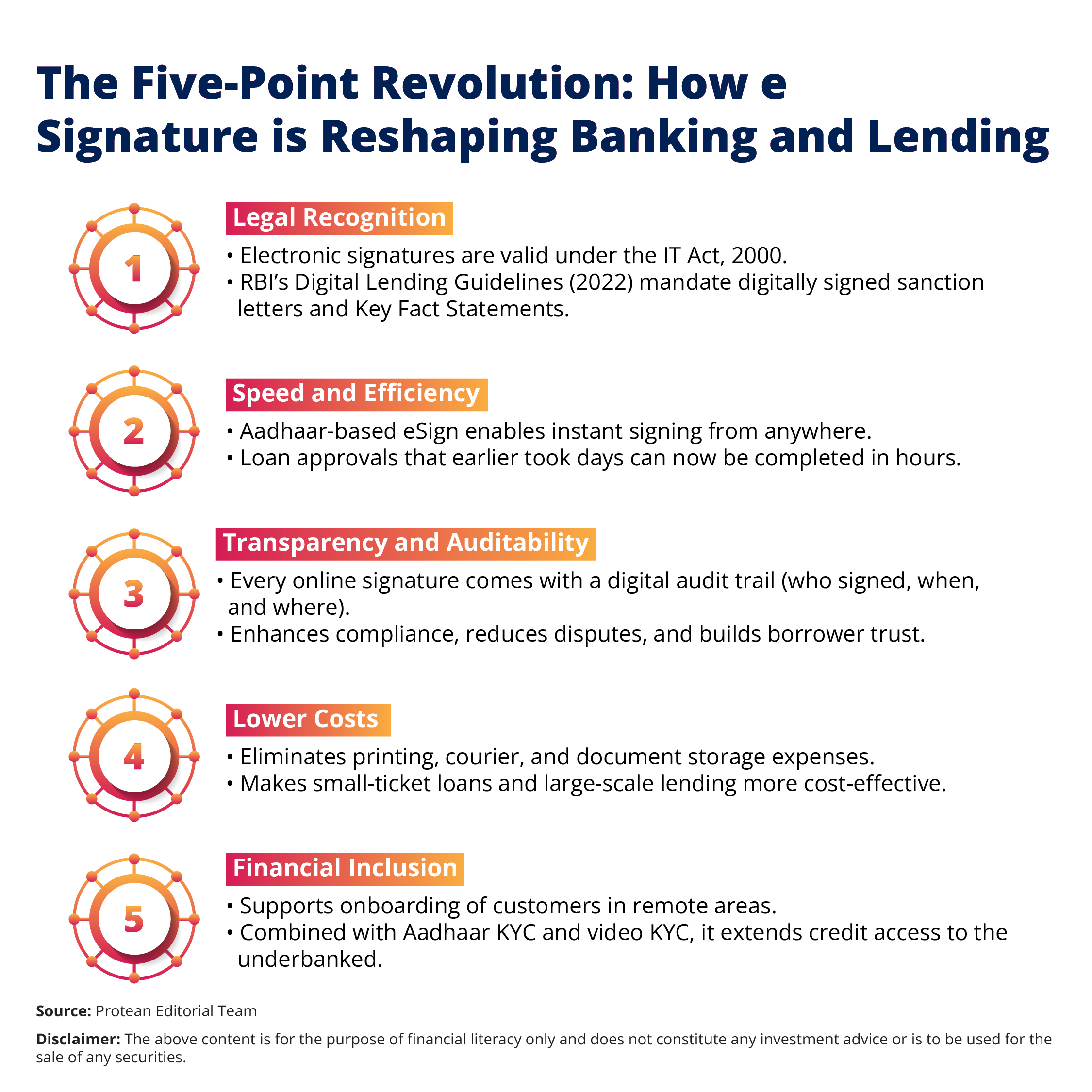How is an online signature or an electronic signature a symbol of digital revolution? It’s because an e signature can help in speedy loan approvals and digital banking procedures.
The rise of the digital world, electronic signature (e signature), Online signature, digital signature are transforming the way institutions and their customers interact.
Regulatory authorities have acknowledged digital transformation to boost secure electronic signatures/digital signatures to make financial services faster, safer, and more inclusive.
In India, regulatory developments have provided a strong momentum to the adoption of e signature technology for a paperless future.
The Problem: The High Cost of Paper-Based Processes
The traditional loan approval process with paper documents can have numerous serious disadvantages:
- Time Delays – The preparation, dispatch, and collection of physical documents, followed by signature verification and storage, can extend processing timelines by several days or even weeks. Borrowers are often required to visit bank branches in person, adding both travel and waiting time.
- Operational Costs – The expenses associated with printing, courier services, storage (including physical filing systems and long-term archiving), and manual labour for repeated verification are significant. Errors such as missing signatures or mismatched forms can further increase costs.
- Risk of Loss, Damage, or Fraud – Paper documents are vulnerable to loss, damage, forgery, or misplacement. Transit delays and the limitations of verifying handwritten signatures can also expose institutions to additional risks.
- Constraints on Scale and Agility – For lenders serving large and geographically dispersed customer bases, reliance on paper slows down operations. In rural or remote regions, logistical challenges can become particularly restrictive.
- Customer Inconvenience – Modern borrowers value speed, transparency, and simplicity. Paper-based processes and physical signatures often create unnecessary friction, especially when multiple supporting documents are required.
These financial, reputational, and service-related costs can place considerable pressure on the banking and lending sector to modernise. This pressure has intensified in recent years with the rapid growth of fintech players, rising customer demand for instant loan approvals, and regulatory initiatives aimed at promoting digital inclusion.

These five points do not function in isolation. Together they can enable a comprehensive transformation of the lending workflow. Banks and NBFCs that invest in good e signature infrastructure, can ensure security (cybersecurity, identity verification), and follow regulatory guidelines stand to benefit most.
Real-World Use Cases in Banking
Here are some concrete examples of how online signature / e signature are being used now in banking and lending in India:
- Digital Lending Platforms: Many fintech lenders now require the borrower to accept and sign the Key Fact Statement (KFS), loan sanction letter, and terms and conditions via digital signature. These are delivered electronically once the borrower completes digital verification. This is mandatory under RBI’s Digital Lending Guidelines.
- Home Loans and Mortgages: Some banks are enabling property documents, agreements, sanction letters, and disbursement forms to be signed online, reducing the need for repeated branch visits. E signature can reduce delays in assembling and validating owner’s signatures, witness signatures, and more.
- Personal Loans and Consumer Credit: For smaller ticket size loans, e signature can allow almost instant sanctioning once the applicant’s identity and creditworthiness are established digitally. Combined with digital KYC this has become a standard in many cases.
- NBFC-Fintech Partnerships: NBFCs partnering with fintechs often outsource parts of the customer acquisition, documentation, and disbursement process. E signature can allow fintechs to collect the required disclosures and signatures online and pass them to the NBFC in compliant form. Under the regulation, even in fintech-driven flows, the lender needs to ensure documents are digitally signed.
Conclusion: The Future of Banking is Paperless
E signature (electronic signature) or online signature are central to this transformation. They can deliver:
- Speed
- Legitimacy
- Cost-efficiency
- Security
- Inclusion
As borrowers expect faster, more transparent services, banks and lenders that resist the shift will be left behind. In the future, paper-based contracts will become the exception, not the norm. The banking and loan approval processes of tomorrow will be built around trust, digital authentication, and seamless electronic signatures.
| To effortlessly digitally sign and stamp documents check eSignPro’s digital documentation suite. |
Frequently Asked Questions
- Are e signatures legally valid in India?
Yes. Under the IT Act, 2000, e-signatures are legally recognised. RBI’s Digital Lending Guidelines also mandate digitally signed disclosures like sanction letters and Key Fact Statements.
- What types of e signature are accepted in banking?
Accepted forms include Aadhaar-based eSign and digital signatures issued by Certifying Authorities, provided they meet IT Act and RBI requirements.
- Are there compliance risks with e signatures?
Yes. Lenders must ensure borrower consent, maintain audit trails, follow RBI’s guidelines, and protect data privacy.
- Do e-signatures apply only to new loans?
No. Even existing digital loans are required to comply with RBI’s rules where feasible.
- How do e signatures help rural customers?
They reduce the need for branch visits through Aadhaar eSign and video KYC. However, digital access challenges in remote areas may require assisted solutions.

